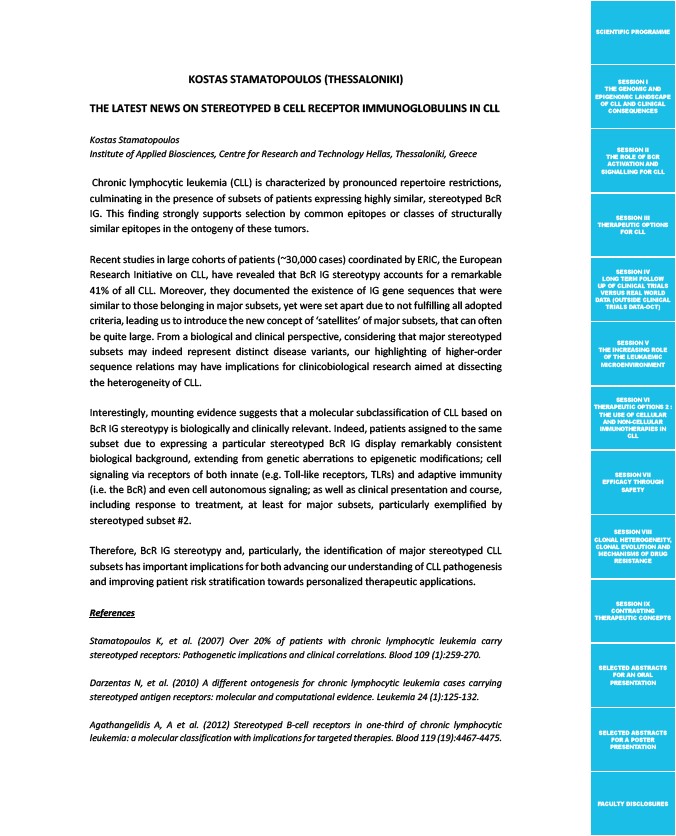
SCIENTIFIC PROGRAMME
SESSION I
THE GENOMIC AND
EPIGENOMIC LANDSCAPE
OF CLL AND CLINICAL
CONSEQUENCES
SESSION II
THE ROLE OF BCR
ACTIVATION AND
SIGNALLING FOR CLL
SESSION III
THERAPEUTIC OPTIONS
FOR CLL
SESSION IV
LONG TERM FOLLOW
UP OF CLINICAL TRIALS
VERSUS REAL WORLD
DATA (OUTSIDE CLINICAL
TRIALS DATA-OCT)
SESSION V
THE INCREASING ROLE
OF THE LEUKAEMIC
MICROENVIRONMENT
SESSION VI
THERAPEUTIC OPTIONS 2 :
THE USE OF CELLULAR
AND NON-CELLULAR
IMMUNOTHERAPIES IN
CLL
SESSION VII
EFFICACY THROUGH
SAFETY
SESSION VIII
CLONAL HETEROGENEITY,
CLONAL EVOLUTION AND
MECHANISMS OF DRUG
RESISTANCE
SESSION IX
CONTRASTING
THERAPEUTIC CONCEPTS
SELECTED ABSTRACTS
FOR AN ORAL
PRESENTATION
SELECTED ABSTRACTS
FOR A POSTER
PRESENTATION
FACULTY DISCLOSURES
KOSTAS STAMATOPOULOS (THESSALONIKI)
THE LATEST NEWS ON STEREOTYPED B CELL RECEPTOR IMMUNOGLOBULINS IN CLL
Kostas Stamatopoulos
Institute of Applied Biosciences, Centre for Research and Technology Hellas, Thessaloniki, Greece
Chronic lymphocytic leukemia (CLL) is characterized by pronounced repertoire restrictions,
culminating in the presence of subsets of patients expressing highly similar, stereotyped BcR
IG. This finding strongly supports selection by common epitopes or classes of structurally
similar epitopes in the ontogeny of these tumors.
Recent studies in large cohorts of patients (~30,000 cases) coordinated by ERIC, the European
Research Initiative on CLL, have revealed that BcR IG stereotypy accounts for a remarkable
41% of all CLL. Moreover, they documented the existence of IG gene sequences that were
similar to those belonging in major subsets, yet were set apart due to not fulfilling all adopted
criteria, leading us to introduce the new concept of ‘satellites’ of major subsets, that can often
be quite large. From a biological and clinical perspective, considering that major stereotyped
subsets may indeed represent distinct disease variants, our highlighting of higher-order
sequence relations may have implications for clinicobiological research aimed at dissecting
the heterogeneity of CLL.
Interestingly, mounting evidence suggests that a molecular subclassification of CLL based on
BcR IG stereotypy is biologically and clinically relevant. Indeed, patients assigned to the same
subset due to expressing a particular stereotyped BcR IG display remarkably consistent
biological background, extending from genetic aberrations to epigenetic modifications; cell
signaling via receptors of both innate (e.g. Toll-like receptors, TLRs) and adaptive immunity
(i.e. the BcR) and even cell autonomous signaling; as well as clinical presentation and course,
including response to treatment, at least for major subsets, particularly exemplified by
stereotyped subset #2.
Therefore, BcR IG stereotypy and, particularly, the identification of major stereotyped CLL
subsets has important implications for both advancing our understanding of CLL pathogenesis
and improving patient risk stratification towards personalized therapeutic applications.
References
Stamatopoulos K, et al. (2007) Over 20% of patients with chronic lymphocytic leukemia carry
stereotyped receptors: Pathogenetic implications and clinical correlations. Blood 109 (1):259-270.
Darzentas N, et al. (2010) A different ontogenesis for chronic lymphocytic leukemia cases carrying
stereotyped antigen receptors: molecular and computational evidence. Leukemia 24 (1):125-132.
Agathangelidis A, A et al. (2012) Stereotyped B-cell receptors in one-third of chronic lymphocytic
leukemia: a molecular classification with implications for targeted therapies. Blood 119 (19):4467-4475.